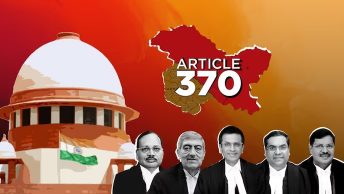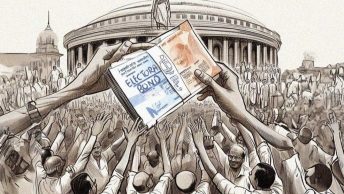[Ed Note: Over the next few days, we shall be discussing Prof. (Dr.) Upendra Baxi’s article titled “Human Rights in the Administration of Criminal Justice: The Concept of Fair Trial” published in the Annual Journal of the National Human Rights Commission, Volume-19, 2020. This is a response to the article by Prof. Jinee Lokaneeta. The introductory post and the links for responses from other commentators can be found here.]
What would a human rights perspective on criminal justice look like in the Indian context? In this landmark essay titled, Human Rights in the Administration of Criminal Justice: The Concept of Fair Trial, Prof. Upendra Baxi invites us to adopt a human rights lens to the criminal justice system which would help transition from an administration of criminal justice (ACJ) to a system of criminal justice (CJS). Baxi stipulates ten commandments or jural postulates of a “civilized” CJS: a “decent and well-ordered society of peoples in which the CJS comports with the core human rights (subsistence, dignity, non-discrimination, liberty, equality, and agency) acknowledged as basic by almost all peoples and nations” (p. 6).
The essay posits these principles at a time when the judiciary and the Constitution often appear to be completely undermined both due to the current political regime and structural conditions. The turn to a human rights discourse (that has undergone numerous critiques as Baxi notes) for CJS is simultaneously a disruptive and generative move. Disruptive since it invites us to move away from only ideological readings and singular narratives of the current political and legal moment and generative as it is precisely when basic rights are becoming the site of struggle, reclaiming their centrality in a rule of law based liberal democracy or as “jural postulates” becomes crucial. I focus here on a couple of commandments from the ten commandments that Baxi notes- freedom from torture and right to counsel during interrogations, as he reminds us that “primary function and role of human rights discursivity is to protect the security and dignity of the individual from tyranny of state power and governmental lawlessness.” (p.3).
Robert Cover famously wrote “(L)egal Interpretation takes place in a field of life and death” (p. 203) to remind judges of the impact of their words on people’s lives. Timothy Kaufman-Osborn noted its significance in executions in terms of a “structure of cooperation,” from words of the judge who pronounced the death sentence to the executioner who implemented it thereby connecting the word and the act usually considered separate. As one observes the proliferation of violations in the CJS, I note that just as the word and the act were connected for legal interpretation to enable violence, any fissure in the “structure of cooperation” has the potential of disrupting the unitary sovereign power of the state and law thereby recognizing the crucial role of “jural postulates” that Baxi suggests.
Baxi reminds us of the “right not to be tortured” as integral to a fair trial. Despite the absence of a specific anti torture law that languishes in the legislative process, there is case law emerging from Article 21 of the Indian Constitution that noted the illegality and impermissibility of torture. The DK Basu safeguards (1996) that emphasize the procedures for arrest and detention are oft recalled and even acknowledged as still inadequate. Yet in the spirit of “jural postulates,” I recall judicial words about what is at stake when torture occurs.
The Supreme Court noted in the DK Basu case, “The increasing incidence of torture and death in custody has assumed such alarming proportions that it is affecting the credibility of the Rule of Law and the administration of the criminal justice system.” In 2020, the Madras High Court, (in part thanks to the intervention of civil liberty groups that have done pathbreaking work on anti-torture campaigns), came up with detailed guidelines for conducting postmortems in custodial death cases. The judgment occasionally reads like a lesson in social contract theory again reiterating the discord between excess violence and state legitimacy. “The foundations of any democratic government rest on popular acceptance. Though State primarily functions through its coercive apparatus, its actions must be perceived as proper by the people. What the government does must inspire the confidence of the people. Every time a custodial death occurs, the legitimacy of the State suffers a big dent. That can be set right only by ensuring transparent investigation. A dead person is equally entitled to justice. I would call it posthumous justice.”
These words from the Madras High Court is a reminder of both the close relationship between state, law and violence and the claim to ensure justice even if posthumously. Custodial deaths continue to be the Court’s focus here, rather than occurrence of torture per se (Lokaneeta, 2012, Chapter 3). Yet these detailed postmortem guidelines suggest a recognition of the import of the words (unrealized from Basu judgment) on lives and deaths. The Supreme Court has recently reiterated the desire for CCTVs in all parts of the police stations. Regardless of efficacies of CCTVs in containing custodial violence, judicial words suggest a shift from focusing on custodial deaths and serious physical torture to a general monitoring of the investigative process- integral to a fair trial as Baxi notes. Perhaps, the words reflect a desire on the part of the Court to finally avoid remand and torture becoming synonymous as they often do, and removing the very need for “posthumous justice.”
A related jural postulate is the right to counsel during interrogations and Baxi calls for “a constitutional requirement that all those called for interrogation, whether as potential suspects, witnesses, or accused (or anonymous persons listed as such and later brought as suspects, witness, or accused) should have a fundamental right for a lawyer to remain present at all venues of interrogation” (p. 11). The significance of such a jural postulate can also be traced back to previous words of the Supreme Court in Nandini Satpathy v. Dani (1978) where the court writes in favor of a lawyer in the pretrial process. The court notes the pressures on suspects (or anyone is custody) recognizing the inherently coercive nature of interrogation that the US Miranda case focused on. The Supreme Court notes, “compulsion includes not only physical threats or violence, but also psychic torture, atmospheric pressure, environmental coercion, tiring interrogative prolixity, overbearing and intimidatory methods and the like.” Thus, even in the absence of physical violence, other pressures can lead to involuntary incrimination. Social hierarchies based on class, caste, gender and religion integrally mediate this experience of custodial interrogation, and physical torture, detention and incarceration especially target the marginalized that considerably worsened during the pandemic (CJPA Report; P Baxi & Singh). Thus, it is imperative to consider the fundamental right for a lawyer in interrogation as Baxi suggests. To that end, Commonwealth Human Right Initiative’s consistent efforts to ensure the right to a counsel to be extended to all stages of custodial interaction of the CJS is a welcome step.
As Baxi connects each of the jural postulates to different parts of the CJS, the role of all levels of judiciary and state/semi-state actors in ensuring a right to fair trial becomes important. Responding to Disha Ravi’s arrest (an environmental activist supporting the inspiring farmers movement), Senior Advocate Rebecca Mammen John noted the important role of magistrates in monitoring remand and procedure: “Personal liberty is inherently linked to the procedural law and if the law is not followed, it results in a gross infringement of a person’s liberty and the right of an individual to fair trial.” Occasionally, the significance of such a liberty is reiterated by a sessions judge while considering a bail application. As the additional sessions judge in the bail hearing for Disha Ravi wrote, “Citizens are conscience keepers of government in any democratic Nation. They cannot be put behind the bars simply because they choose to disagree with the State policies… The right to dissent is firmly enshrined under Article 19 of The Constitution of India.” While the wider failure of judiciary in upholding civil liberties in numerous contexts including in the last decade are numerous, each such order is a reminder of what an adherence and reiteration to a “jural postulate” can mean. Another crack in the “structure of cooperation” appeared in the context of Dalit activists, Shiv Kumar and Nodeep Kaur’s detention and custodial violence due to their support for industrial workers’ wages and farmers protests. Medical doctors played a revelatory role in laying out the evidence of the physical torture and custodial violence on Kumar’s (and Kaur’s) bodies (PUDR 2021). Thus, rights regarding different sites of the investigative process- right to counsel, bail, right to be protected from a media trial (Umar Khalid), right to a medical examination are themselves being claimed by those subjected to the denial of rights, and the actors responsible for keeping police in check (even as they are a part of the policing apparatus) are occasionally recognizing the import of the words. To go back to cover one more time, a crack or fissure in the “structure of cooperation” in the legal process too has the impact of breaking the cycle of violence and violation of human rights. It is a reminder to the police as Baxi notes, that “The police function is crucial in so many ways for social order; it rightly consists of prevention of crimes and treatment of offenders but for that reason it is scarcely sovereign or trans-constitutional.” (p. 16). s
Above all, Prof. Upendra Baxi’s important essay is a plea to scholars, activists, and legal actors to consider these jural postulates not just at the level of everyday practice as tactics or strategies but remind one of the centralities of these human rights as the very basis of a rule of law-based system. He writes: “…Ten Commandants of criminal law and jurisprudence… should be an integral part of public constitutional culture, not only of judicial but also legislative, bureaucratic, and enforcement cultures and all other structures/ networks in a well-ordered and just society.” (p. 7) To the extent that constitutionalism is intricately related to the question of liberty and equality, the essay is a reminder of the imperativeness of ensuring these rights in the CJS.
References
Baxi, Pratiksha & Navsharan Singh. “Gendering the Pandemic in the Prison. The India Forum August 7, 2020.
Criminal Justice & Police Accountability Project. Countermapping Pandemic Policing: A Study of Sanctioned Violence in Madhya Pradesh. 2020.
Cover, Robert. “Violence and the Word.” In Narrative, Violence and the Law: the Essays of Robert Cover, edited by Austin Sarat, Michael Ryan and Martha Minow, 203-238. Ann Arbor: University of Michigan Press, 1992.
Kaufman-Osborn, Timothy V. From Noose to Needle: Capital Punishment and the Late Liberal State. Ann Arbor: Michigan University Press, 2002.
Lokaneeta, Jinee. Transnational Torture: Law, Violence and State Power in the United States and India. Orient Blackswan, 2012.







m6fgmn